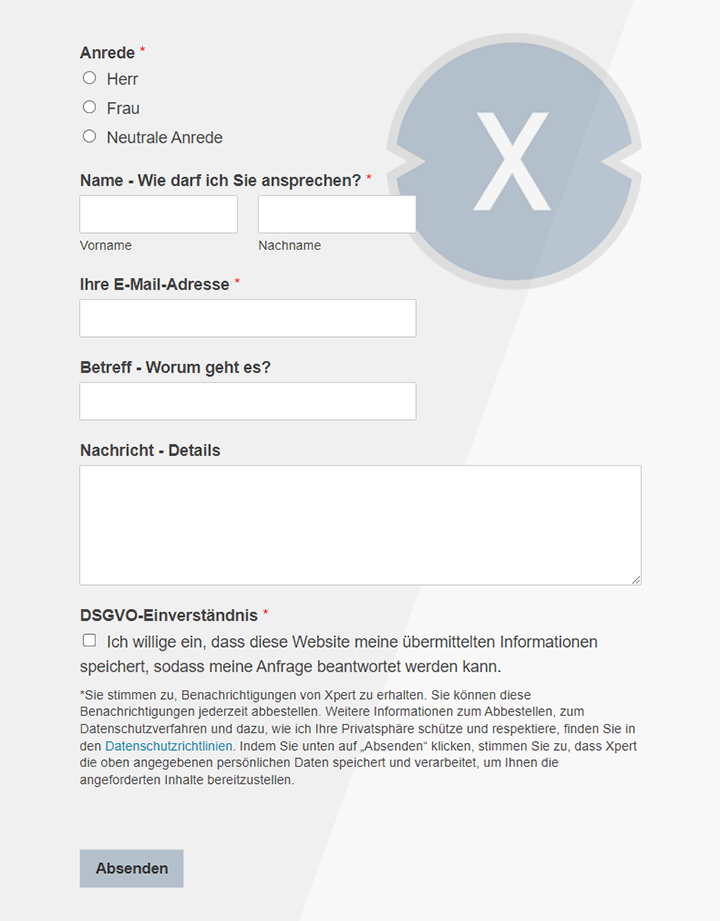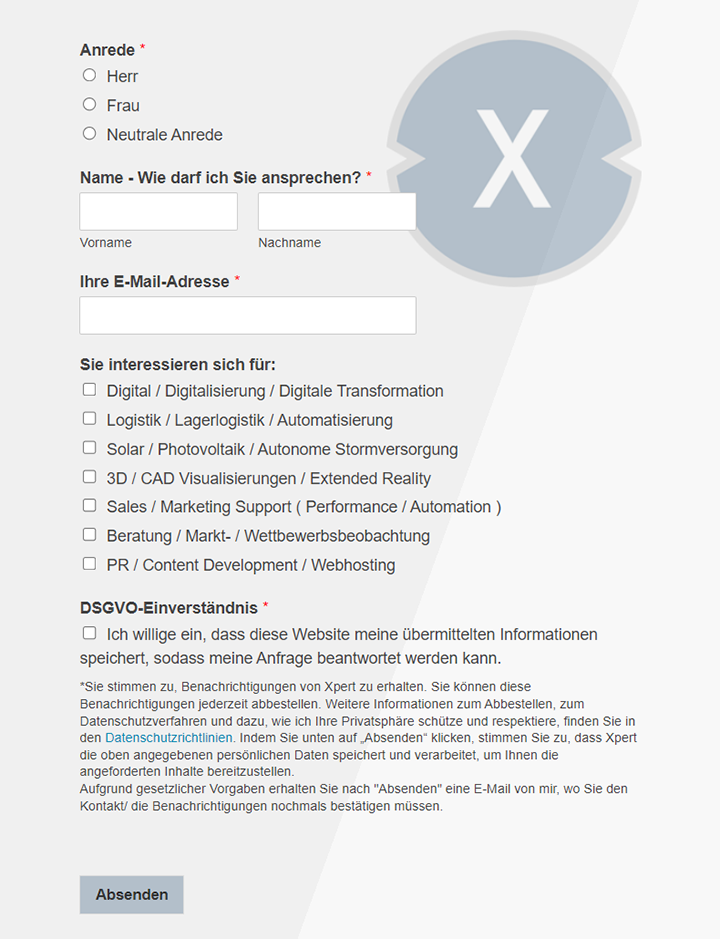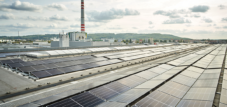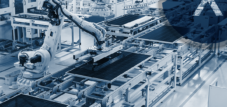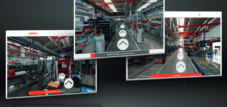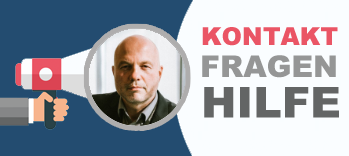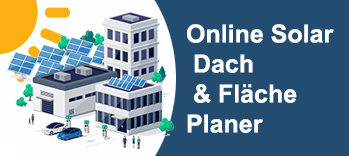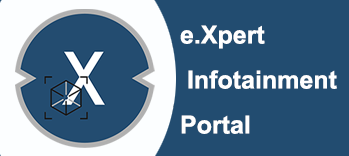Goods from the street on the rail: Logistics hobs & high-tech-locations for envelope, logistics, trade and production
Xpert pre-release
Language selection 📢
Published on: May 19, 2025 / update from: May 19, 2025 - Author: Konrad Wolfenstein

Goods from the street to the rail: Logistics hobs & high-tech-locations for envelope, logistics, trade and production-Image: Xpert.Digital
Location development: How the rail can transform freight traffic
With strategy for sustainable logistics: the key to relocating freight traffic
The relocation of freight traffic to rail is a central transport and environmental policy goal in Germany that requires significant progress. This article analyzes the requirements and solutions for the development of locations for envelope, logistics, trade and production to achieve this goal. The railroad contains considerable potential as a sustainable and reliable alternative to fault -prone logistics chains, but the implementation of this potential depends crucially on the availability of suitable locations with efficient rail access. The core challenges include ensuring the reliability of the rail transport for the loading economy, the immense need for areas and adequate envelope points, the increasing competition around locations with other uses and the complex task of regional land use planning. Furthermore, mobility and commercial traffic strategies must be integrated and the rail infrastructure must be secured and expanded. The use of synergies, such as the combination of photovoltaic systems with logistics properties, offers additional optimization potential. The article identifies critical success factors and formulates strategic recommendations to set the course for future -proof transfer of freight transport. The urgency and the multi -layered nature of the necessary measures require a concerted approach of all actors involved.
Suitable for:
The strategic need: more goods on the rail
Current landscape of rail freight transport in Germany: performance, Modal Split and key trends
The rail freight transport (SGV) in Germany is faced with the challenge of significantly increasing its share in the Modal Split in order to achieve traffic and environmental policy goals. The proportion of rail transport is currently around 18-20 %, while road freight transport is dominated by around 71-73 %. The Federal Government has issued the ambitious goal to increase the SGV's modal split share to at least 25 % by 2030. This target brand illustrates the considerable discrepancy to the current situation and underlines the extent of the efforts that are already required by 2025 to swing on this path.
A look at the market structure shows that DB Cargo holds an important market share of 41 %, but the private rail traffic companies (EVU) provide a larger share with 59 % of the traffic performance. This distribution signals that political and infrastructural measures must not only be geared towards the former state monopolists, but also to a diversified market with diverse actors.
Forecasts indicate continued growth of the entire freight traffic. The Federal Transport Infrastructure Plan expects annual growth of the traffic performance of 1.6 %, and Baden-Württemberg expects annual growth of 1.7 % over all modes of transport by 2030. This development would continue to put pressure on the already heavily loaded street infrastructure if no substantial relocation should be possible. The relocation is therefore essential not only for ecological reasons, but also essential to avoid a traffic collapse.
The goal of a 25 %modal split share by 2030 is ambitious, but could still mean in view of the forecast total growth of freight transport that a very large volume is still transported on the street. The time horizon 2025, which is often mentioned, must be viewed as a critical milestone. Although no explicit, quantified modal split goal is called for 2025 in many overarching documents, the general demands for “more goods on the rail” indicate that the framework conditions that make it possible have to be created. The dominance of private providers in the SGV also requires that infrastructure planning and access conditions are designed competitive and take into account the needs of a large number of surgeons to promote innovation and efficiency - key factors for successful transportation.
Why rail? Sustainability, resilience and economic advantages
The arguments for the stronger use of the rails in freight transport are diverse and convincing. At the forefront are the ecological advantages: rail freight transport is significantly more energy-efficient-up to five times more than the truck-and causes significantly fewer CO2 emissions. Any ton transported on the rail can save 80-100 % of CO2 emissions compared to road transport. A single freight train has the potential to replace up to 52 trucks, which underlines resource efficiency. Another plus is the high degree of electrification: 97 % of the traffic performance in SGV is already electrically provided today.
In addition to sustainability, security also plays an important role. On the rails, goods, in particular dangerous goods, are much more secure than on the street, with a risk of accidents up to 42 times less compared to the truck. For Germany as a leading export nation and central transitland in Europe, powerful rail freight transport is of strategic economic importance.
However, the argument of the “resilience” of the rail as an alternative to fault -prone logistics chains requires a differentiated view. The rail offers an alternative to road transport, but the rail network itself is susceptible to disorders at individual nodes, as the incident in Rastatt showed. A lack of availability of diversion routes and inadequate emergency concepts can affect reliability. In order to develop the rail into a really robust alternative, considerable investments in network redundancies and effective fault management are necessary. The purely existence as an alternative to the street does not automatically make the rail completely resilient.
The economic advantages of the rail, such as the replacement of a large number of trucks, come into play, especially on long distances and when transporting mass or heavy goods. Due to the system, the rail is often less competitive for shorter distances and time -critical, smaller programs. Studies show that a large part of the transports over distances are handled under 200 km, a segment in which only a few companies have a direct track connection. Combined traffic (KV) is often only considered economically profitable from distances of 300 km or 200 km in seaport. Location development strategies must therefore be nuanced: You should promote the segments in which the rail has natural advantages and at the same time drive innovations to improve competitiveness in other areas, for example through efficient KV terminals and optimized connections for the first and last mile.
Superordinate political framework: national and regional ambitions
The relocation of freight transport to the rail is supported by a multi-layered political landscape at the federal and state level. At the national level, the Master Plan form rail freight transport and the Germany clock of central pillars. The master plan defines measures to strengthen the SGV, while the Germany is striving for optimized use of the rail network for passenger and freight transport. In addition, the 2030 climate protection plan sets overarching environmental goals.
In Baden-Württemberg, these ambitions are reflected in specific regional strategies. The Baden-Württemberg freight transport concept and the goal of transporting every second tonum in a climate-neutral manner by 2030 are in charge. The 2030 public transport strategy and the state concept of mobility and climate, which are embedded in the overall context of sustainable mobility, are also indirectly relevant. The state development plan plays a key role in surface protection.
Despite these ambitious political objectives at the federal and state level, there is a perceptible discrepancy for concrete implementation. Industrial associations repeatedly complain about a lack of consistent and quickly financed implementation of the necessary measures. This discrepancy between long-term goals and the short-term implementation, which is insufficiently perceived, creates uncertainty for location developers and investors who, however, need planning security for the realization of the “goods” targets.
The success of national strategies depends largely on the proactive commitment and the planning skills of the regional and local regional authorities. In particular, the land use planning and the production of local infrastructure connections are crucial here. The approach of Baden-Württemberg, with the establishment of a “freight transport competence center” and specific terminal development plans, could serve as a model. National plans can specify the direction, the identification of locations, permits for the use of land and local connections are inherently regional and local tasks. A lack of comparable proactive measures in other federal states could achieve the national target children.
Nationale and Baden-Württemberg rail freight traffic destinations (2025/2030)
Note: Explicit modal split goals for the SGV in Baden-Württemberg for 2025 or 2030 are not directly quantified in the available sources, but are derived from the overarching climate protection goals and the strategy for decarbonization of traffic.
The national and Baden-Württemberg rail freight transport goals for 2025 and 2030 include various aspects. By 2030, the modal split share of rail freight transport (SGV) should be at least 25 %, which is implicitly linked to the climate goals. It is also sought to reduce CO2 emissions in the traffic sector by 55 % compared to 1990 than part of the climate protection plan. Another goal is to realize a climate -neutral goods transport by 2030 by becoming climate -neutral. A nationwide digital traffic model is to be implemented by 2025. In addition, the increase in GVFG funds for local transport to 2 billion euros per year is sought with the support from federal funds. The degree of electrification of the rail network should be 70 % at the federal level by 2025 and 75 % by 2030, according to the coalition agreement and the goals of the federal government.
Development of important locations for rail -centered logistics, trade and production
Identification and securing optimal locations: dealing with land use competition
Securing suitable areas is the basic first step to relocate more goods to the rail. However, this process is characterized by considerable space competition. Logistics and industrial locations compete intensively with demands from the areas of living, agriculture and environmental protection. The regional land use planning (regional plans) has a key role in this area of tension. It is the central instrument to predict, show and secure suitable areas for logistics and industry with rail connections.
The location choice criteria are complex and require careful considerations. The most important factors include sufficient area size (often over 10 hectares), good multimodal development (street, rail, rail, possibly waterway), the proximity to traffic hubs, the general availability of the areas, expansion options as well as the minimization of usage conflicts with adjacent residential buildings and ecologically sensitive areas. In view of the increasing area pressure, innovative land use concepts are becoming more important. The “stacking”, ie the multi-storey construction of industrial and logistics systems, is discussed as a way to use more efficiently in Germany.
The effectiveness of regional land use plans when securing locations for rail -savvy logistics not only depends on the pure designation, but also decisively on the enforceability of these determinations compared to competing development interests and the speed of the approval process. Long approval processes, a general problem in Germany, can also delay the implementation of land use plans. If, once designated logistics areas can be easily rededicated for more profitable uses such as housing construction or the process of activating your activation is too lengthy for logistics purposes, the goals for 2025 are endangered.
A potential conflict results from the need for large, consolidated logistics areas with good rail connection, which often arise on the “green meadow” due to the space requirement, and the sustainability goals to reduce surface sealing (keyword “net zero”). This requires increased focus on the revitalization of fallow land (Brownfield development) and the optimization of existing industrial areas. However, such approaches can bring about their own challenges, such as costs for contaminated sites or restrictions due to existing infrastructure. The development of new, large locations for rail logistics must be carefully weighed up against these area savings goals and innovative solutions on existing or reused areas must be pushed.
In addition, inter -municipal and interregional cooperation in location planning is essential, since optimal logistics locations do not always match the limits or priorities of individual municipalities. Regional markets, such as that of the Frankfurtrheinmain region, and the coordinating role of regional associations are of great importance. Without such coordination, there is a risk of fragmented and suboptimal location development.
Infrastructural requirements for seamless rail integration
Private track connections: technical, operational and economic feasibility
Private track connections are the direct key to rail freight transport for many companies in the invited economy and industry. Their meaning is undisputed, although their number has decreased significantly in the past decades. For example, DB Cargo still served 2,100 connections in 2000, in 2020 there were only 1,500. The reactivation of disabled and the construction of track connections are therefore central building blocks of a successful transfer of traffic.
The construction and operation of a track connection are subject to specific technical and operational requirements. These are defined by guidelines and requirements of the Federal Railway Office (EBA), DB Infrago AG as the largest infrastructure operator and associations such as the VDV (Association of German Transport Companies). In addition to the technical feasibility, the prerequisites also include a sustainable operating concept, the guarantee of a network connection by a railway infrastructure company (EIU) for at least five years as well as the commitment of a railway traffic company (EVU).
The cost of a track connection can be significant. Funding programs of the federal government exist to create investment incentives. These can cover up to 50 % of the grant -capable costs for track connections and up to 80 % for multifunctional systems, whereby the funding amount must be at least EUR 15,000. Planning costs are also eligible up to an altitude of 17.5 %. Despite these funding, the reactivation or new building remain a challenge for many companies due to bureaucratic hurdles and the need to demonstrate economy in individual cases. Initiatives such as the “track connection charta” aim to reduce these systemic obstacles and improve the framework conditions.
However, the economy of a new or reactivated track connection does not depend solely on the construction costs and funding. Rather, the long -term operational reliability and cost competitiveness of the rail traffic service, which is provided at this connection, is crucial. Uncertainties in these areas can prevent companies from investing despite available grants. General problems with the reliability of rail freight transport can undermine the profitability of a track connection. If a company invests in a track connection, but is then faced with unreliable or overpriced rail traffic services, the original investment quickly becomes a “beached asset”. Therefore, the development of track connections must go hand in hand with binding commitments in terms of service quality and predictable pricing on the part of the EVU and EIU.
A “one-size-fits-all” approach in the development of track connections is also not useful. The technical and operational requirements for a track connection for a chemical plant that may handle dangerous goods and special wagon types differ significantly from those for a general logistics store or a automobile plant with just-in-time requirements. For example, the transport of REA-GIPS requires special wagons. While the need for track connections for certain logistics functions in the past have not always been seen, they gain new importance in the context of sustainability and increase in efficiency. Funding programs and planning support must take this industry -specific diversity into account and enable tailor -made solutions.
Charging points: design, functionality and sector -specific needs
Public charging points, such as those operated by DB Infrago AG, are an alternative for companies without their own track connection. They serve to load and unload rail and road vehicles as well as the envelope between these two transport companies. The “track connection charta” also addresses the improvement of the framework conditions for such loading points.
The operation and use of charging offices are subject to strict environmental requirements, in particular with regard to noise (TA noise), dust emissions (TA air) and the handling of water -hazardous fabrics (AWSV). Especially in the vicinity of residential buildings, time restrictions, especially night handling bans, can exist. Restrictions also generally apply to the handling of liquid water hazardous substances at DB Infrago AG charging points.
The current environmental law and operational restrictions of many existing public charging points, such as night driving bans or restrictions on the handling of dangerous goods, can limit their usability for certain industrial branches or for logistics processes that require 24/7 operation. Modern logistics chains are often dependent on a round-the-clock operation, and industries like the chemical industry naturally transport substances that could fall under the restrictions mentioned. If public charging points are too limited, your role is limited to facilitate rail access for a wider corporate base. This could increase the pressure to build more (costly) private track connections or to develop new, modernly equipped public transshipment systems so as not to endanger the relocation goals. The accessibility, capacity and operational flexibility (e.g. opening times, permitted goods specified) are therefore decisive factors for the attractiveness of public charging points.
Terminals of combined traffic (KV): Strategic planning, capacity expansion and technological progress
KV terminals are strategically indispensable interfaces in multimodal freight transport. They enable the street, rail and, if necessary, waterway and play a key role in coping with long-distance freight transport and relief for the street infrastructure. The development of a dense network of powerful KV terminal is therefore of vital importance.
The planning and construction of KV terminals require considerable investments. The federal government promotes private investments in new and expansion with up to 80 % of the grant costs. The essential components of a KV terminal include envelope devices such as portal cranes or REACHSTACKEN, envelope tracks with sufficient usage (at least 600 meters, ideally designed for 740-meter trains), lanes for trucks as well as storage and storage areas for loading units. The capacity is usually measured in TEU (Twenty-Foot Equivalent Unit) or loading units (LE). The extension of the Kornwestheim terminal can serve as an example, which, with a new module of 25,000 m2, strives for a capacity of around 1,000 charging units per day. A usual conversion is 1 LE = 1.54 TEU, as practiced using Cologne.
Important location factors for KV terminals are the proximity to industrial and trade centers as well as a good connection to the national road and rail network. A maximum street connection (forward and in charge) of 30 to 75 km is recommended. Technological advances such as automation, digitization and consistent accessibility with 740-meter trains are crucial for increasing efficiency.
The cost-effectiveness and performance of KV terminals depend heavily on the folded volumes. This leads to a classic “henne-egg problem”: Sufficient quantities are necessary to justify investments in new or expanded terminals, at the same time a lack of terminal capacity can inhibit quantity growth. This underlines the need for proactive, demand -anticipating investments. In order to bridge the initial profitability gaps in new terminals, strategic public co -stations or risk division mechanisms may be required.
Although federal funds are available for KV terminals, the location identification, regional planning approval and local integration (management of traffic, noise) remain significant hurdles. These can delay projects and thus endanger the achievement of the goals by 2025. The example of the Terminal Ulm-Dornstadt illustrates this lengthy process: From admission to the federal traffic schedule in 2016 to the planned commissioning at the end of 2027- significantly according to the time horizon 2025 focused here. This suggests that the acceleration of these “soft” factors, ie the planning and approval processes, is as important as ensuring financing.
Suitable for:
- Stuck on the rail: Unpunctual freight trains as the core problem of the supply chain - solutions and recommendations
Baden-Württemberg in focus: a case study on proactive terminal and location development
Baden-Württemberg pursues a comprehensive and proactive approach to promoting rail freight transport, which can serve as a valuable case study. The country has set itself the ambitious goal of transporting every second ton of goods by climate by 2030. This goal is supported by a bundle of measures that are anchored in the Baden-Württemberg freight transport concept. An important building block is the development of a digital nationwide traffic model that also includes freight traffic data and is intended to support infrastructure planning.
The competence center of freight transport located at the local transport company Baden-Württemberg (NVBW) plays a central role. It serves as a counseling and networking point and supports companies, especially small and medium-sized, when switching to rail. In 2024 alone, twelve consultations were carried out, from which a potential shift potential of 350,000 to 400,000 tons per year was identified.
In the area of terminal development, Baden-Württemberg is driving several projects:
- Horb: A new terminal was put into operation that represents an important expansion of the cover offer in the country.
- Kornwestheim: An expansion of the existing terminal is planned.
- Ulm-Dornstadt: This significant expansion project is part of the federal traffic route plan. The planning has been running since 2016, and the draft and approval planning should be completed by the end of 2020, the planning approval procedure will be initiated in early 2021. Construction is scheduled for 2024 and commissioning for the end of 2027.
- Reutlingen and Lahr: There are feasibility studies or concrete plans for these locations.
- Oberschwaben (Pfullendorf): Location examinations were carried out, whereby Pfullendorf was identified as a potentially suitable location, but has not yet been reactivated.
To finance these measures, the state has launched its own funding guideline for the decarbonization of freight traffic, which complements federal funding and closes gaps. There are also specific support programs for e-trucks and the associated charging infrastructure (truckcharge@bw, bw-e-trucks).
However, the long periods for large-scale projects such as Ulm-Dornstadt, even with priority treatment and state support, illustrate that the creation of significant new terminal capacities is a major challenge. The focus must therefore also be on the optimization of existing systems and smaller, faster realizable modernizations, parallel to initiation of these long -term strategic projects.
The existence of a dedicated “Competence Center for Freight Transport” in Baden-Württemberg represents a potential best practice solution for other federal states. Such an institution can close the gap between political goals and practical implementation by supporting companies (in particular SMEs) in the complex task of relocating traffic. The lack of such focused support in other regions could be a limiting factor for achieving the national goals.
Comparative requirements for rail access: production locations vs. logistics hubs vs.

Comparative requirements for rail access: Production locations vs. Logistics hubs vs. Cover terminals - Image: Xpert.digital
The comparison of the requirements for the rail access between production locations, logistics hubs and cover terminals shows clear differences that result from the respective operational needs. Production locations such as in the chemical industry need a direct track connection with often specialized loading systems and high capacity for the delivery of raw materials and the removal of products. The security standards are particularly high because dangerous goods are often handled. Kettle, silo and special freight cars are typically used here, which are loaded and unloaded with fixed loading bridges, pumps or crane -able systems. The operating frequency is regular and needs-oriented, and there is a high need for maneuvering and storage tracks as well as direct or indirect connection to the main network.
Another production site, such as in the automotive industry, requires a just-in-time-compatible connection with precisely tackled loading processes. Closed freight wagons, container wagons or car transport vehicles are often used, which are loaded via ramps, forklifts or automated systems. Such locations need a very good connection to the main network, while dealing with dangerous goods is less typical. More general production locations often offer more flexible track connection for different goods and can integrate storage areas. Covered freight wagons, trolleys or containers are used here, and the loading and unloading technology includes mobile ramps, forklifts or indoor cranes. The operating frequency varies depending on the production cycle and a good connection to the rail network is desirable.
Logistics hubs and warehouses have other requirements. A rail connection for the input and output is essential here, especially for the connection with distribution networks and, if necessary, cross-docking processes. Long charging controls as well as the use of covered freight wagons, containers and exchange bridges are typical, with ramps, forklifts and conveyor techniques being used. The operating frequency is regularly and adapted to the streams of goods, and a good connection to main stretches and combined time terminals is necessary. Dealing with dangerous goods is product -specific here.
KV handling terminals have the highest technical requirements. You need several long cover tracks with a minimum length of 600 to 740 meters, lanes for trucks, storage areas for loading units and powerful envelope. Your rail and street connection must be optimal. All combined traffic units such as containers, alternating bridges and cranisable saddle trailers are used here. Portal cranes, reach stackers and further specialized envelope are used, even for non -crane units. The operating frequency is very high, with clocked drives. The direct connection to main stretches and the integration into national traffic corridors are essential, whereby the handling of dangerous goods must correspond to the legal regulations.
🎯🎯🎯 Benefit from Xpert.Digital's extensive, fivefold expertise in a comprehensive service package | R&D, XR, PR & SEM

AI & XR 3D Rendering Machine: Fivefold expertise from Xpert.Digital in a comprehensive service package, R&D XR, PR & SEM - Image: Xpert.Digital
Xpert.Digital has in-depth knowledge of various industries. This allows us to develop tailor-made strategies that are tailored precisely to the requirements and challenges of your specific market segment. By continually analyzing market trends and following industry developments, we can act with foresight and offer innovative solutions. Through the combination of experience and knowledge, we generate added value and give our customers a decisive competitive advantage.
More about it here:
From bureaucracy to efficiency: accelerate planning and approval in rail freight transport
The hurdles master: core challenges for the expansion of rail freight transport
Improvement of reliability and punctuality: meet expectations of the loaders
The reliability and punctuality of rail freight transport are decisive factors for acceptance in the invitation and freight forwarders. Companies that are dependent on just-in-time supply chains or closely clocked production processes can hardly afford unpredictable rail traffic. The punctuality statistics show potential for improvement here. In 2018, for example, DB Cargo recorded a punctuality rate of 72.7 %, which means that more than every fourth freight train had a delay of at least 15 minutes. The general punctuality of the rail (DB group) in Germany was 90.1 % in 2023, a slight decline compared to 90.9 % in 2022. The integrated report 2024 of the 2024 shows a “punctuality in Germany” of 88.1 % (forecast as of February 2025: 89.4 %). The causes of unpunctuality include network overload, high construction work, infrastructure disorders and operational challenges.
The published punctuality statistics may not fully depict the reliability in freight transport experienced by the customer. Goods transport often include more complex chains than passenger traffic, including the lead and follow-up on the street as well as envelope processes in terminals. A more granular, consistent performance measurement for freight traffic, which takes into account the entire transport chain, is therefore necessary. Delays in maneuvering, terminal processes or delivery on the last mile can be critical for the freight customer, even if the main run of the train was considered punctual according to certain definitions.
The extensive construction and modernization measures, such as the “high-performance network” of the DB Infrago, aim at a long-term improvement in reliability, but will inevitably lead to considerable short to medium-term disorders. This could worsen the perceived reliability in the period until 2025 before improvements. The DB Infrago itself reports on the effects of increased construction activities on the punctuality of all types of transport. This requires excellent communication strategies and effective measures to catch the effects in order not to further endanger the acceptance of rail freight transport.
Suitable for:
Elimination of infrastructure bottlenecks and expansion of the network capacity
The physical capacity of the rail network represents an essential limiting factor for the growth of rail freight transport. The German rail network has shrunk in the past decades, while the volume of traffic has increased. This leads to bottlenecks on many important corridors. The Association of German Transport Companies (VDV) has identified a list of over 800 necessary measures to remove the bottlenecks and expansion of capacity.
The “high -performance network” strategy of the DB Infrago aims to tackle this problem by releasing a total of 40 highly loaded corridors by 2030. Further key measures to increase capacity include the electrification of the network, the upgrading of routes for longer freight trains (740 meters) and the digitization of leading and security technology (ETCS, digital signal boxes). According to the coalition agreement, the degree of electrification is expected to increase to 70 % by 2025 and 75 % by 2030, starting from currently around 60 %.
However, the pace of critical infrastructure upgrades, especially in electrification and elimination of bottlenecks, is worryingly slow. In 2024, for example, only 48.2 kilometers of new rail routes and only 5 kilometers of new electrification were realized, which was referred to as the “sad balance”. The aim of electrifying 75 % of the network by 2030 is increasingly out of reach. Since large-scale projects such as the high-performance network have a time horizon by 2030, it is unlikely that substantial capacity increases can be realized by extensive new or expansion by 2025. Capacity gains by 2025 are therefore expected to result from operational optimizations, smaller expansion measures and better exploitation of the existing infrastructure.
The “Germany clock”, which aims to use optimized network use, could unintentionally disadvantage freight traffic if the priorities of passenger transport are not carefully balanced with the needs of freight transport. It is postulated that goods and passenger transport are equal every Germany, but personal trains in network load calculations are often dealt with priority. Especially in the case of construction measures or disorders on heavily used mixed traffic routes, there is a risk that politically more sensitive passenger traffic will actually receive priority in the assignment of remaining capacities, which further affects the reliability of freight transport. The development of locations for freight transport must therefore be accompanied by robust mechanisms for capacity allocation that effectively protect freight traffic streets.
Ensuring financial sustainability: Investment models and financing mechanisms
The financing of the necessary infrastructure measures and innovations is a central aspect for strengthening rail freight transport. Significant funds have already been promised: the performance and financing agreement III (LuftV III) provides EUR 86 billion over a period of ten years for the preservation of federal railways. The funds from the municipal transport law (GVFG) for local transport infrastructure were increased to EUR 2 billion per year from 2025. The rail freight transport master plan provides for an increase in the funds for new and expansion to EUR 3 billion per year.
The rail associations are calling for long -term securing infrastructure financing and reforming infrastructure fees (route prices). The association “The Früterbahnen” criticizes the coalition agreement in 2025 for a financing perceived as inadequate or miscalved and in particular rejects user financing for infrastructure expansion and replacement. There are specific support programs for track connections, KV terminals, decarbonization measures in Baden-Württemberg and innovations such as the digital automatic coupling (DAK).
The debate about “user financing” of the rail infrastructure is of critical importance. If increasing route prices are used to finance the infrastructure, this could make rail freight transport more expensive and its competitiveness compared to the street, which does not fully cover their infrastructure and external costs. This would be in direct contradiction to the aim of relocating traffic and would have a significant impact on the perspectives by 2025.
The effectiveness of the various specific funding pots also depends on the accessibility for applicants (in particular SMEs), the speed of the approval procedures and the orientation of the funding criteria on the most urgent needs to achieve the 2025 goals. Bureaucratic hurdles can have a significant deterrent effect here. The existence of counseling centers such as the “Competence Center for Freight Transport” in Baden-Württemberg, which supports the company in the use of funding, underlines the need to facilitate access to financial aid. If funding is available, but difficult to maintain or only accessible with a great time delay, their effect will be limited by 2025.
Tightening of regulatory framework and acceleration of approval procedures
Light planning and approval procedures are a well-known obstacle to infrastructure projects in Germany and also affect rail freight transport. Even if areas are secured and funds available, delays can hinder projects that are to have an effect by 2025. This applies to the construction of terminals as well as the reactivation of track connections.
The “track connection charta” explicitly calls for the reduction of bureaucracy and the simplification of regulations for access points to the rail network. Even if the coalition agreement provides for 2025 measures to accelerate planning and approval, critics indicate that the main reason for planning is often not in planning law itself, but in a lack of planning capacities for authorities and project providers as well as in medium-sized provision.
Efforts to accelerate planning procedures for large federal projects, such as those anchored in the federal traffic route plan, do not automatically lead to faster permits for smaller, privately financed or regionally initiated locations such as track connections or logistics parks. For this “last mile” infrastructure elements, specific attention and adapted procedures are required. The development of numerous decentralized locations involves a large number of local authorities and different approval paths. Without a targeted simplification and acceleration for these smaller, but decisive elements for a comprehensive connection, the goals of a broad location development will hardly be achieved by 2025.
Selected funding programs for rail freight traffic infrastructure and innovation in Germany and Baden-Württemberg

Selected funding programs for rail freight traffic infrastructure and innovation in Germany and Baden-Württemberg-Biard: Xpert.digital
Selected funding programs for rail freight traffic infrastructure and innovation in Germany and Baden-Württemberg include a variety of measures. This includes the Federal Funding Promotion Directive, which promotes new and expansion, reactivation and replacement of track connections and multifunctional systems. Companies with private legal form can be supported with up to 50 % (for track connections) and up to 80 % (for multifunctional systems), with a minimum amount of EUR 15,000. Another funding measure is the KV terminal support, which supports private investments in new or expanded combined transport cover plants from EUR 100,000, with a non-repayable grant of up to 80 %. The federal program "Future rail freight transport", on the other hand, is aimed at promoting innovations, such as automated processes, and provides EUR 30 million annually (until 2024). In addition, the performance and financing agreement is used to preserve the federal rail trails, with EUR 86 billion being planned for over ten years. The Federal Local Transport Financing Act promotes investments in local transport infrastructure, including rails, whereby the funds will be increased annually from 2025 to EUR 2 billion.
There are other specific support programs in Baden-Württemberg. The funding guideline for decarbonizing freight transport supports the construction or conversion of freight traffic interfaces for CO₂ reduction with a funding of up to 50 % of the eligible costs, provided that at least one ton of CO₂ per 100,000 EUR is saved. With “TruckCharge@BW”, the structure of charging infrastructure for e-trucks is promoted, with SMEs in particular benefit from up to 40 % grant for quick charging stations. The "BW-E-Trucks" program also promotes the purchase of emission-free trucks (electrical or fuel cell) by buying, leasing or conversion of the vehicle classes N2 and N3. Depending on the size of the company, funding of up to 60 % is granted, even if the funds are already exhausted for 2024.
🎯📊 Integration of an independent and cross-data source-wide AI platform 🤖🌐 for all company matters

Integration of an independent and cross-data source-wide AI platform for all company matters-Image: Xpert.digital
Ki-Gamechanger: The most flexible AI platform-tailor-made solutions that reduce costs, improve their decisions and increase efficiency
Independent AI platform: Integrates all relevant company data sources
- This AI platform interacts with all specific data sources
- From SAP, Microsoft, Jira, Confluence, Salesforce, Zoom, Dropbox and many other data management systems
- Fast AI integration: tailor-made AI solutions for companies in hours or days instead of months
- Flexible infrastructure: cloud-based or hosting in your own data center (Germany, Europe, free choice of location)
- Highest data security: Use in law firms is the safe evidence
- Use across a wide variety of company data sources
- Choice of your own or various AI models (DE, EU, USA, CN)
Challenges that our AI platform solves
- A lack of accuracy of conventional AI solutions
- Data protection and secure management of sensitive data
- High costs and complexity of individual AI development
- Lack of qualified AI
- Integration of AI into existing IT systems
More about it here:
Strategies for the transformation of intermodal transport solutions: rail as the key to the future
Important lever to accelerate "goods on the rail"
Optimization of intermodal transport chains for continuous efficiency
The combined traffic (KV) is considered a central growth market and a crucial lever to shift goods to the rail. However, his success depends on the seamless and efficient integration of all modeors involved - rail, street and, if necessary, waterway. In particular, the truck-supported lead and follow-up to the terminals plays a critical role in the competitiveness of the entire intermodal chain. There are often challenges in the KV during the handling times at the terminals, the costs for the forefront and afterrise (drayage) and in the flow of information between the various actors and modes of transport. A report by the European Court of Auditors (ECA) underlines that intermodal transports are often more expensive than pure road transports and are also confronted with infrastructural and regulatory hurdles.
In order to achieve a real traffic shift, the entire intermodal chain in relation to costs, time and reliability must be able to compete with continuous road transport. This requires optimization approaches that go beyond pure rail transport. The success of newly created or expanded rail locations (terminals, logistics parks) is inseparable with the performance and cost efficiency of the street-bound advance and in-case run. Investments in the rail infrastructure must therefore be supplemented by strategies to optimize these street connections. This includes addressing problems such as the lack of driver in road freight transport and potentially the promotion of low-emission trucks for feeding services, such as that is done in Baden-Württemberg with programs for e-trucks. Without efficient, inexpensive and reliable road connections to the rail cover points, the entire intermodal offer suffers, regardless of the performance of the rail transport itself.
Suitable for:
- Du logistics² | Double dual-use logistics: integration of rail and street for civil and military purposes
Use innovations: digitization (DAK, ETCS), automation and modern rolling material
Technological innovations are a crucial factor in making rail freight transport more competitive, more efficient and attractive. In the area of digitization and automation, the focus is on several key technologies:
- The digital automatic coupling (DAK) promises significant efficiency increases in maneuvering and the train formation. Their introduction is supported by the federal government and is a core claim of the industry.
- The European Train Control System (ETCS) and digital signal boxes are intended to increase network capacity, improve security and increase reliability.
- Automation technologies are increasingly applying to KV terminals and marshalling stations, such as the test field for digitized and automated train formation in the Munich-Nord maneuver station.
- Modern rolling material, such as quieter freight wagons with so -called “whisper brakes” and more energy -efficient locomotives, contributes to environmental compatibility and acceptance of rail freight transport.
- Digital platforms for booking, tracking and management of freight improve transparency and customer friendliness.
However, the implementation of these technologies, in particular in the network of effective systems such as ETCs or the DAK, is a lengthy and costly process. The full benefit of such innovations will only develop with a nationwide, ideally Europe -wide introduction. For the time horizon 2025, it can be assumed that the effects on pilot projects or first rollout phases will be limited. This means that other efficiency measures are required at short notice to achieve the goals. Location planning should anticipate these future technologies, but should not rely on their full availability solely for the immediate future. The gradual introduction and the associated transition phases require careful planning and management in order to use the potential of the innovations in the best possible way without excessive burden on ongoing operation.
Use synergies: Integration of renewable energy solutions (e.g. photovoltaics on logistics systems and cover terminals)
The integration of photovoltaic systems (PV) on logistics buildings and cover terminals offers significant synergy potential and is explicitly addressed in the task of this report. The large roofs of logistics properties are ideal for installing PV systems. A study shows that logistics buildings are more often equipped with PV, but there is still an enormous potential for very large halls (big-box logistics with over 50,000 m2), since around 81 % of these roofs do not yet have any solar systems. Federal states such as Baden-Württemberg and Bavaria take on a pioneering role here.
In addition to roof areas, the use of noise protection walls along traffic infrastructures (rail, street) for PV current generation is also increasingly becoming the focus. There are already successful pilot projects and implementations in Germany, for example in Aschaffenburg, Neuötting, Waltershofen and Neumarkt, as well as specific projects in Baden-Württemberg (Ladenburg, Wendlingen). The Federal Ministry of Digital and Transport (BMDV) has also analyzed the potential of PV on federal highways and sees opportunities in the double-digit gigawatt area.
The profitability of PV systems depends on various factors, including investment costs, electricity prices, self-consumption rates and feed-in remuneration. The primary driver for the installation of PV at logistics locations is currently covering your own needs to reduce energy costs, since the feed -in tariffs are less attractive than in the past. The location of the location-including the potential electricity requirements for the operation of cranes, cooling units, building technology and especially for charging electric trucks-thus becomes a key factor for the interpretation and profitability of the PV system. The combination of PV generation with the loading of e-truck on site, as supported by funding programs in Baden-Württemberg, is a particularly promising synergy.
While the installation of PV systems on building roofs is relatively uncomplicated, the integration of PV into noise protection walls on terminals or along railway lines more complex, regulatory and safety-relevant challenges. Aspects such as glare for road users, sound reflection, maintenance accessibility in ongoing rail operations and specific planning and approval requirements must be addressed for a broader application near operated rail systems. These factors mean that the implementation of the PV potential in railway-specific infrastructure requires more specialized solutions and approval procedures than with standard roof systems in the commercial sector.
Implementation of coherent mobility and commercial traffic strategies
The relocation of goods to the rail cannot be viewed in isolation, but must be an integral part of comprehensive mobility and commercial traffic strategies. Such strategies must take into account the interaction of all modes of transport and be tailored to the overarching goals of economic development, urban logistics, port connections and also passenger traffic (which competes for the same tight rail capacities).
The “Regional Economic Transport Strategy Frankfurt Rheinmain” serves as an example of a regional, multi-stakeholder approach. In Baden-Württemberg, the “freight traffic concept” and the “state concept mobility and climate” form the framework for an integrated transport policy.
However, effective commercial traffic strategies have to go beyond pure funding measures for the rails. You have to actively make less sustainable modes of transport unattractive, for example by a polluter-appropriate road usage fee or CO2 prize, which is not compensated for directly by other subsidies. A pure “pull” strategy for the rail, without simultaneous “push” factors for road freight transport, will hardly lead to a quick and significant shift in traffic by 2025. The economic advantages of road transport (flexibility, often as less perceived direct costs) are significant. Without the stronger internalization of the external costs of road freight traffic (CO2 emissions, traffic jams, infrastructure wear), the rail, even with improved locations, will often be inferior in the pure price competition. The demand of the Baden-Württemberg Minister of Transport after an expansion of the truck toll underlines this necessity.
Strategic recommendations for realizing the rail freight transport goals
In order to achieve the goals of the “goods on the rail” and to enable substantial relocation of freight traffic, concerted efforts and strategic course are required. The following recommendations are aimed at various actors at the federal and state levels as well as the private sector.
Targeted political and regulatory reforms
- Acceleration of planning and approval procedures: A significant tightening and acceleration of the approval procedures are required especially for track connections, KV terminals and rail-savvy logistics locations. This includes reducing bureaucratic hurdles and strengthening the planning capacities at the responsible authorities.
- Ensuring fair competitive conditions: The regulatory framework must be designed in such a way that a fair competition between the various railway traffic companies and between rail and road is guaranteed. This includes a critical review and, if applicable, reform of the route prize system in order to create cost truth and incentives for rail use. Subsidies for road freight transport that weaken the competitive position of the rail must be avoided.
- Strengthening the liability of area instructions: Regional land use plans not only have to identify logistics areas with rail connection, but also ensure their use for this purpose in the long term and binding. Mechanisms to prevent redoms in favor of other, more profitable uses at short notice must be established.
- Establishment of clear, measurable intermediate destinations: For the development of locations (number of new/reactivated track connections, new terminal capacities), clear, measurable and annual intermediate destinations should be determined by 2025/2030. Transparent monitoring of progress is essential in order to be able to initiate corrective measures at an early stage.
Prioritized infrastructure investments and development
- Focus on a bottleneck disposal with effect until 2025: Investments in the rail infrastructure should be concentrated at short notice on measures that have already brought noticeable capacity and reliability improvements for freight traffic by 2025. This includes the removal of bottlenecks on accessing routes to important business locations and terminals.
- Acceleration of key terminal projects: The implementation of strategically important KV terminal projects must be accelerated through priority treatment in planning and approval procedures as well as through secure financing. At the same time, the optimization and capacity expansion of existing terminals should be promoted.
- Promotion of track connection reactivation and the new building: The existing funding programs for track connections must be kept attractive and access, especially for small and medium-sized companies (SMEs). A “Brownfield First” and compression principle should be actively promoted in the location development for logistics, supported by adapted funding instruments and simplified regulations for the conversion of existing industrial and commercial space, including multi-storey systems.
- Consistent expansion of the digital infrastructure: the introduction of ETCs, digital signal boxes and the DAK must be followed in emphasis to increase the performance and efficiency of the rail network in the long term.
Promotion of cooperation between industry and state actors
- Strengthening cooperation platforms: Initiatives such as the “Future Alliance Schiene” are to be further developed and used as central platforms for dialogue and coordination between politics, infrastructure operators, transport companies and invited economy.
- Promotion of regional competence centers: The establishment of regional competence centers for freight traffic based on the model of Baden-Württemberg should be checked and promoted nationwide. These can act as an important intermediary between the company and administration and support the practical implementation of the transfer of traffic.
- Intensification of inter-municipal and interregional cooperation: The planning and development of logistics locations and KV terminals requires increased coordination across municipal and regional borders in order to find optimal and needs-based solutions.
- Integration of the invading economy and logistics service provider: The needs and requirements of the potential users of the rail must be included in planning and development processes at an early stage in order to ensure practical and accepted solutions.
Pave a way to a robust and sustainable future of rail freight transport
The relocation of more freight traffic to rail by 2025 is an ambitious but strategically indispensable goal for Germany. The development of suitable locations for envelope, logistics, trade and production with efficient rail access is the linchpin for the success of this initiative. As the analysis has shown, the rail is an ecologically advantageous and potentially very reliable transportation agent, but the potential of which can only be raised by overcoming significant challenges.
The core problems include securing space in competition with other uses, the need for massive investments in a powerful and reliable infrastructure, the elimination of bottlenecks, acceleration of lengthy planning and approval processes as well as the creation of fair competitive conditions. The reliability of the rail transport must be noticeably improved for the invading economy and the costs for access and use of the rail must be made competitive.
The time horizon 2025 is extremely tight for the implementation of transformative changes in the physical infrastructure. Therefore, a dual strategy is essential: On the one hand, all options for increasing efficiency and optimizing existing systems and processes must be exploited in the short term in order to achieve measurable relocation effects by 2025. This includes minor expansion measures, the reactivation of disabled track connections and the improved utilization of existing terminal capacities. On the other hand, the course for larger, strategic location developments must be set in parallel, whose implementation goes beyond 2025, but are of crucial importance for achieving long -term goals by 2030 and beyond. This requires forward -looking planning, secure financing and accelerated approval procedures.
The successful implementation of the “goods on the rail 2025” agenda requires a paradigm shift towards an integrated transport and location policy that focuses on sustainability, efficiency and competitiveness equally. A persistent commitment of all actors - from the federal government to the federal states and municipalities to the infrastructure operators and the private sector - is essential to make the German freight transport landscape sustainable. The use of synergies, such as the integration of photovoltaic systems, can make an additional contribution to economy and sustainability. Only through a concerted and determined action can the goal be achieved to establish the rail as the backbone of a modern and environmentally friendly freight traffic system.
Significant challenges in relocating goods to the rails and corresponding strategic solutions

Significant challenges in relocating goods to rail and corresponding strategic solutions - Image: Xpert.digital
Significant challenges in relocating goods to rails result from factors such as the availability of space, the infrastructure capacity, reliability, the costs, planning and approval procedures, inefficient interfaces, lack of track connections and unused synergy potential. Proactive regional land use planning with securing logistics locations, promoting Brownfield development and inter-municipal cooperation could minimize the competition with suitable areas. At the same time, prioritized investments in network expansion, electrification, the removal of bottlenecks as well as the introduction of modern technologies such as ETCs and digital signal boxes should be overcome. In order to increase punctuality and reliability, improvements on the high -performance network, optimized construction site management and the introduction of digital operating systems are crucial. With regard to the high costs and uncertain economy, the focus is on the reform of route prices, accessible support programs and the promotion of innovation in the company, for example through automation. Light planning and approval procedures could be made more efficient through legal accelerations, standardized processes and digital application channels. For the optimization of the interfaces and the “first/last mile”, KV terminals should be expanded and advanced and follow-ups are supported by low-emission trucks. Attractive support programs and simplified requirements could promote missing track connections, while advisory services offer companies additional incentive. Finally, synergy potential could be exploited better by installing PV systems on logistics buildings and transshipment systems and integrating e-charging infrastructures.
Advice - planning - implementation
I would be happy to serve as your personal advisor.
Head of Business Development
Chairman SME Connect Defense Working Group
We are there for you - advice - planning - implementation - project management
☑️ SME support in strategy, consulting, planning and implementation
☑️ Creation or realignment of the digital strategy and digitalization
☑️ Expansion and optimization of international sales processes
☑️ Global & Digital B2B trading platforms
☑️ Pioneer Business Development
I would be happy to serve as your personal advisor.
You can contact me by filling out the contact form below or simply call me on +49 89 89 674 804 (Munich) .
I'm looking forward to our joint project.
Xpert.Digital - Konrad Wolfenstein
Xpert.Digital is a hub for industry with a focus on digitalization, mechanical engineering, logistics/intralogistics and photovoltaics.
With our 360° business development solution, we support well-known companies from new business to after sales.
Market intelligence, smarketing, marketing automation, content development, PR, mail campaigns, personalized social media and lead nurturing are part of our digital tools.
You can find out more at: www.xpert.digital - www.xpert.solar - www.xpert.plus











